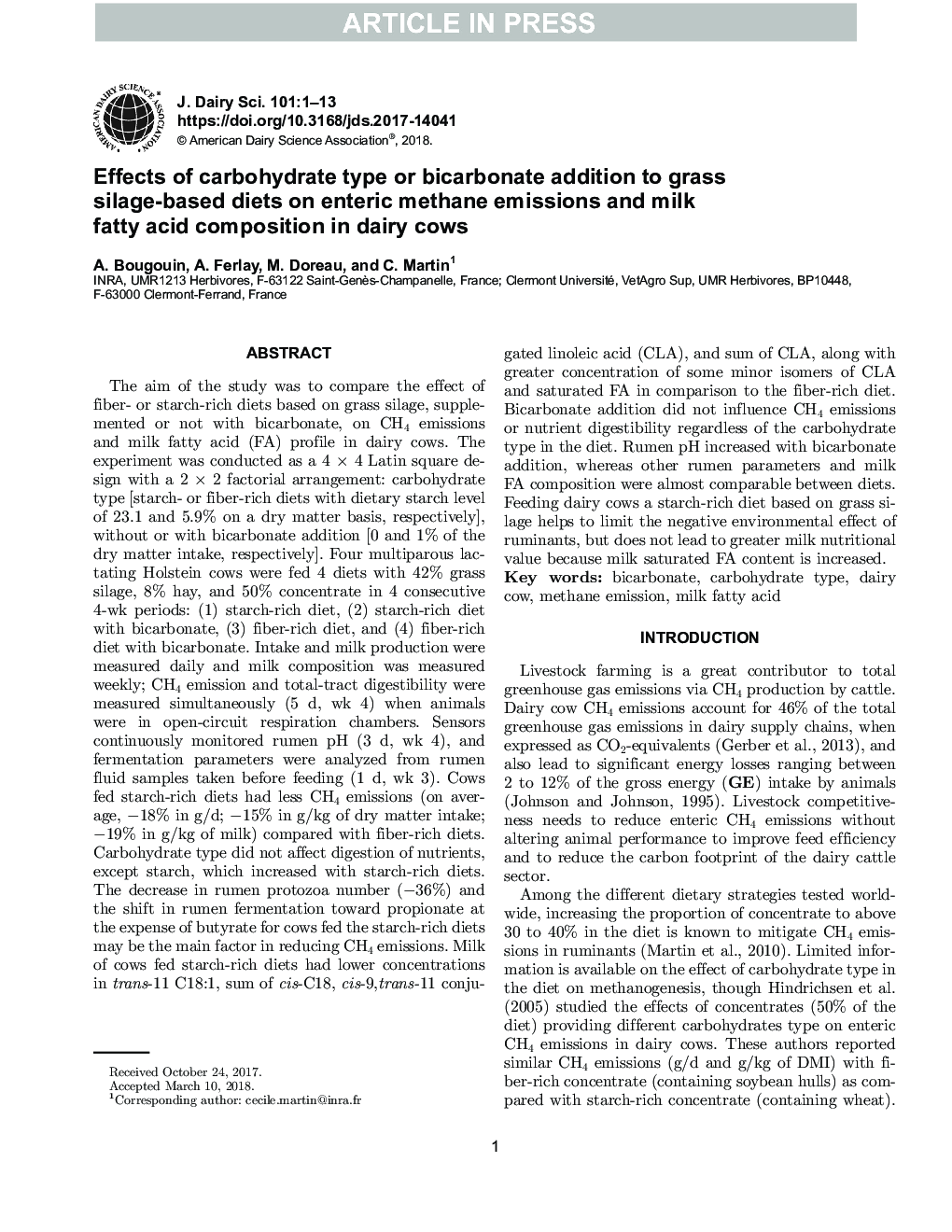| کد مقاله | کد نشریه | سال انتشار | مقاله انگلیسی | نسخه تمام متن |
|---|---|---|---|---|
| 8500995 | 1553838 | 2018 | 13 صفحه PDF | دانلود رایگان |
عنوان انگلیسی مقاله ISI
Effects of carbohydrate type or bicarbonate addition to grass silage-based diets on enteric methane emissions and milk fatty acid composition in dairy cows
ترجمه فارسی عنوان
تأثیر نوع کربوهیدرات یا افزودن بی کربنات به رژیم های مبتنی بر سیلاژ چمن بر میزان انتشار گازهای گلوتامین و ترکیب اسید چرب شیر در گاوهای شیری
دانلود مقاله + سفارش ترجمه
دانلود مقاله ISI انگلیسی
رایگان برای ایرانیان
کلمات کلیدی
بی کربنات، نوع کربوهیدرات، گاو شیری، انتشار گاز متان، اسید چرب شیر
موضوعات مرتبط
علوم زیستی و بیوفناوری
علوم کشاورزی و بیولوژیک
علوم دامی و جانورشناسی
چکیده انگلیسی
The aim of the study was to compare the effect of fiber- or starch-rich diets based on grass silage, supplemented or not with bicarbonate, on CH4 emissions and milk fatty acid (FA) profile in dairy cows. The experiment was conducted as a 4 Ã 4 Latin square design with a 2 Ã 2 factorial arrangement: carbohydrate type [starch- or fiber-rich diets with dietary starch level of 23.1 and 5.9% on a dry matter basis, respectively], without or with bicarbonate addition [0 and 1% of the dry matter intake, respectively]. Four multiparous lactating Holstein cows were fed 4 diets with 42% grass silage, 8% hay, and 50% concentrate in 4 consecutive 4-wk periods: (1) starch-rich diet, (2) starch-rich diet with bicarbonate, (3) fiber-rich diet, and (4) fiber-rich diet with bicarbonate. Intake and milk production were measured daily and milk composition was measured weekly; CH4 emission and total-tract digestibility were measured simultaneously (5 d, wk 4) when animals were in open-circuit respiration chambers. Sensors continuously monitored rumen pH (3 d, wk 4), and fermentation parameters were analyzed from rumen fluid samples taken before feeding (1 d, wk 3). Cows fed starch-rich diets had less CH4 emissions (on average, â18% in g/d; â15% in g/kg of dry matter intake; â19% in g/kg of milk) compared with fiber-rich diets. Carbohydrate type did not affect digestion of nutrients, except starch, which increased with starch-rich diets. The decrease in rumen protozoa number (â36%) and the shift in rumen fermentation toward propionate at the expense of butyrate for cows fed the starch-rich diets may be the main factor in reducing CH4 emissions. Milk of cows fed starch-rich diets had lower concentrations in trans-11 C18:1, sum of cis-C18, cis-9,trans-11 conjugated linoleic acid (CLA), and sum of CLA, along with greater concentration of some minor isomers of CLA and saturated FA in comparison to the fiber-rich diet. Bicarbonate addition did not influence CH4 emissions or nutrient digestibility regardless of the carbohydrate type in the diet. Rumen pH increased with bicarbonate addition, whereas other rumen parameters and milk FA composition were almost comparable between diets. Feeding dairy cows a starch-rich diet based on grass silage helps to limit the negative environmental effect of ruminants, but does not lead to greater milk nutritional value because milk saturated FA content is increased.
ناشر
Database: Elsevier - ScienceDirect (ساینس دایرکت)
Journal: Journal of Dairy Science - Volume 101, Issue 7, July 2018, Pages 6085-6097
Journal: Journal of Dairy Science - Volume 101, Issue 7, July 2018, Pages 6085-6097
نویسندگان
A. Bougouin, A. Ferlay, M. Doreau, C. Martin,
